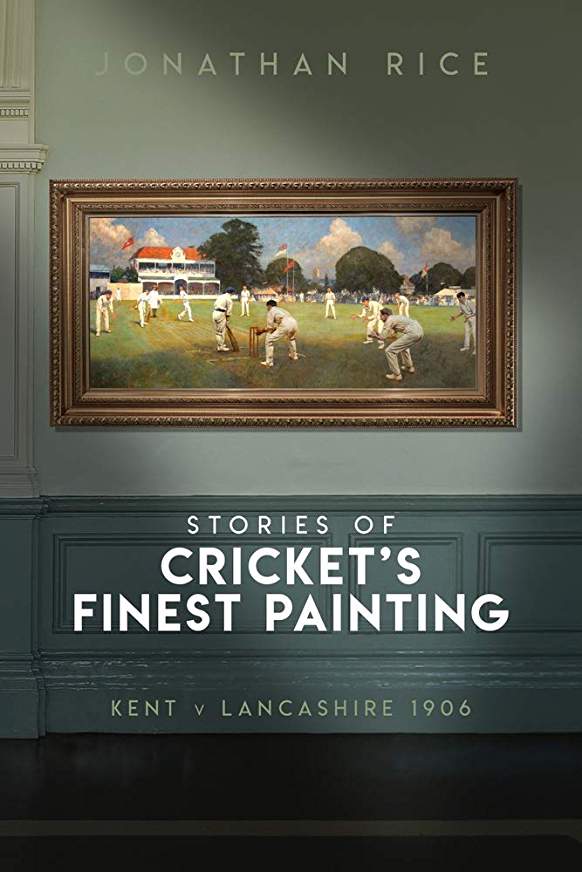My new book, Stories of Cricket’s Finest Painting: Kent v Lancashire 1906, is published on 10 July. This is the second longest title to any book I have so far written (beaten only by Hyacinth Bucket’s Book of Etiquette for the Socially Less Fortunate, 56 letters to my latest at 45 letters plus 4 digits) but it took a lot more research than Mrs. Bucket’s volume.

The subject is, I will admit, a niche one, concerning a painting completed in 1907 of two teams of long dead cricketers playing at Canterbury in high summer. You may well conclude that only followers of the history of cricket in Kent, and possibly Lancashire, will find it of interest, but I hope you are proved wrong. If that is indeed my market, then sales will not be enough for me to buy my first Rolls Royce, which has been my plan all along. A Lego version perhaps, but not the real thing. However, I (and my publishers) hope that the appeal of the book is wider than that.
The painting was commissioned by Lord Harris, then chairman and Lord High Everything Else at Kent County Cricket Club, to celebrate the county winning the County Championship for the first time It was painted by Albert Chevallier Tayler, a fine if not quite a great artist who, however, knew and loved his cricket. This painting was to prove his masterpiece. It shows the moment when the wonderful Kent left hand bowler Colin ‘Charlie’ Blythe prepares to bowl to one of the finest batsmen of his generation, Johnny Tyldesley of Lancashire, with the rest of the Kent eleven eagerly anticipating the delivery. Perhaps the significance to the painting is that it captures a moment just before the action: does not show stumps flying or fielders diving to take a brilliant catch. The painting is not a glorification of Kent’s success, it is a glorification of the game of cricket itself.
Cricket in England in 1906 was very different from the game we see today. In 1906 there was no limited overs cricket, no white balls, no reverse sweeps or scoops, and not even any Test matches that year. But it was still one of the most glorious summers of cricket that many people had ever experienced. The sun shone, records tumbled, and Kent just pipped Yorkshire to the title. If Yorkshire had not lost their last but one game of the season, against Gloucestershire, by the narrowest possible margin – one run – when Gilbert Jessop trapped Yorkshire’s last man lbw as time was running out, then Yorkshire would have been champions and Kent would have to have waited until 1909 for their first title.
The painting itself was an artistic success, but not a commercial success. Despite many attempts to sell prints to members, non-members and any passing browser, the costs of commissioning the painting and producing the prints exceeded the income received, and it was not until 2006, when the Kent CCC committee decided to sell the painting, that its commercial worth was recognised. The painting had for some years before that been housed at Lord’s, because the club could not afford the insurance cover, and a copy had been made by the Yorkshire artist Barrington Bramley and hung in the Chiesman Pavilion at Canterbury (but that’s another story), so the decision to sell at a time of some financial struggle was not a hard one. The sale, through Sotheby’s, yielded a hammer price of £600,000, at the time the highest price ever reached for a cricket painting, and thanks to the generosity of the buyer, the Andrew Brownsword Foundation, the painting still hangs on long term loan in the pavilion at Lord’s. Mr. Brownsword himself was educated at the Harvey Grammar School in Folkestone, Leslie Ames’ alma mater, which might explain his fondness for Kent cricket.
Cricket art was greatly influenced by the painting, which is still one of the very few that portrays a complete eleven in the field, in action in a real match. There have been many paintings of moments from cricket matches, and many portraits of cricketers either singly or in groups, but the all-inclusive concept behind Chevallier Tayler’s painting, originally known as The County Eleven In The Field, was entirely original and has never been replicated on such a large, or such a successful, scale.
In researching the book, I have had a great time going through the local press of the time, finding out about Canterbury Week in the Edwardian era, the Old Stagers, the man in the crowd who was hit by a six and needed to be revived by the St. John Ambulance man, and all the players involved in the match itself (not to mention the the one who wasn’t). I have written about the way the Kent club was formed, how Canterbury Week began and grew, and about the lives of the players and umpires in the painting. I have also compared cricket in 1906 with cricket today, not always, I fear, to the advantage of 2019. The Hundred, anyone?
Stories of Cricket’s Finest Painting: Kent v Lancashire 1906, by Jonathan Rice, published by Pitch Publishing on 10 July, £18.99
0 Comments